Tremella mesenterica Retz. - Yellow Brain Fungus
Phylum: Basidiomycota - Class: Tremellomycetes (insertae sedis) - Order: Tremellales - Family: Tremellaceae
Distribution - Taxonomic History - Etymology - Identification - Culinary Notes - Reference Sources
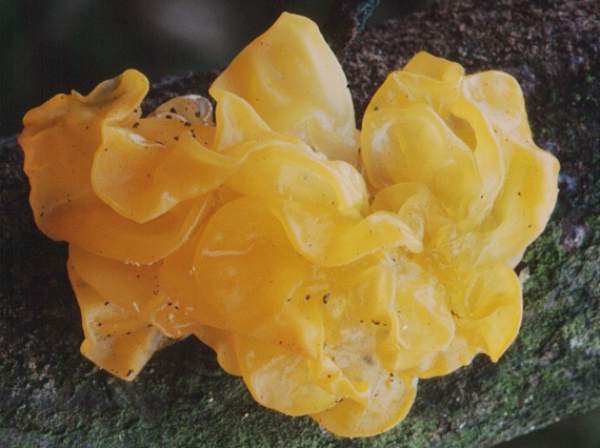
Tremella mesenterica, the Yellow Brain Fungus, is mainly seen in winter, when it appears on fallen branches of deciduous trees. In dry weather this fungus becomes a hard orange bracket and it much more difficult to spot.
Late summer and autumn are the best times to look for this species, which is capable of both sexual and asexual reproduction: it propagates not only via basidiospores but also by producing conidiospores.
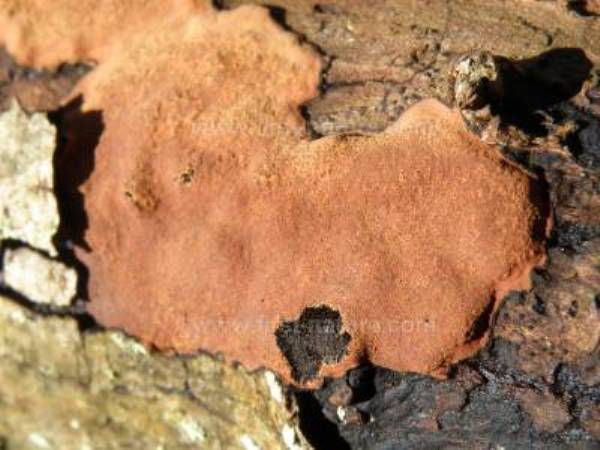
Yellow Brain fungus grows on dead wood that has been attacked by wood-rotting fungi of the Peniophora genus. One of the most common Peniophora crust fungi in Britain and Ireland is Peniophora incarnata, commonly known as Rosy Crust fungus. Very little or none of the Peniophora may be visible; this is because Tremella mesenterica feeds on the mycelium of the Peniophora fungus, and that can be deep inside the timber rather than on its surface. The fruiting body of the crust fungus does not even have to be present, therefore, and so it may look as though Yellow Brain is feeding directly on the host wood.

Distribution
This attractive jelly fungus is found throughout Britain and Ireland as well as in other European countries. Yellow Brain fungus has been recorded in in temperate regions of Asia, Australia and both North and South America. You need wet weather to find this fungus easily: during dry spells it shrivels into a hard-to-spot thin rubbery patch on the host wood.
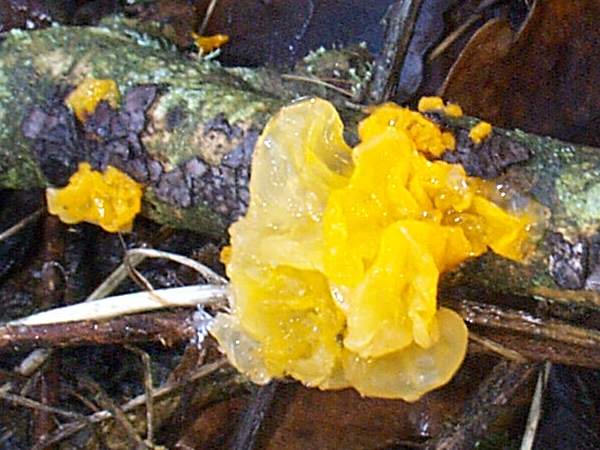
The Yellow Brain fungus pictured on the left is feeding on the grey corticioid fungus Peniophora limitata, a species which is almost exclusively found on dead wood from Ash trees, Fraxinus excelsior. Ash Dieback disease may provide increased opportunities for this crust fungus and hence also for Tremella mesenterica.
Taxonomic history
This jelly fungus was originally described in 1769 by Swedish botanist Anders Jahan Retzius (1742 - 1821), who called it Tremella mesenterica, by which name mycologists still refer to it today.
Synonyms of Tremella mesenterica include Exidia candida, Tremella albida, Tremella candida, Tremella lutescens Pers., and Hormomyces aurantiacus Bonord.
Tremella mesenterica is the type species of the genus Tremella.
Etymology
Tremella, the generic name means trembling - a reference to the wobbly-jelly-like structure of fungi within this grouping, The specific epithet mesenterica is derived from two Ancient Greek words meso- meaning middle, and -enteron meaning intestine, suggesting that this fungus looks more like a middle intestine that a brain.
Identification guide
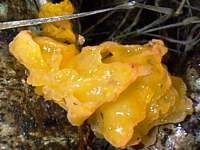 |
FruitbodyUsually golden yellow and gelatinous when damp, turning orange and shriveling to a tiny fraction of its former size during very dry weather; initially disc-like, the fruitbody soon develops irregular contortions only very vaguely resembling the structure of a brain. Individual fruitbodies grow to between 2 and 8cm across. |
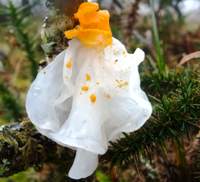 |
If you are very lucky you may come across the white Tremella mesenterica var. alba, but it is quite a rare find, at least in Britain and Ireland. The splendid specimen on the left was photographed by Vaisey Bramley, with whose kind permission it is shown here and in Pat O'Reilly's new book , where you can learn more about this and hundreds of other wacky, weird and wonderful mushrooms, toadstools, brackets, crusts, cups, fairy clubs, puffballs and jelly fungi with which we share our environment. Note: Fruitbodies of Tremella mesenterica, yellow form, become significantly paler when exposed to prolongued rain, but they retain a distinctly yellow tinge. |
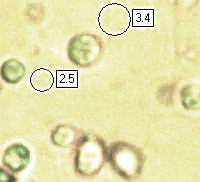 |
BasidiaBroadly ellipsoidal, smooth, cruciately septate (divided by walls into four compartments so that seen from the top they look rather like 'hot cross buns') Basidiospores7-16 x 6-10µm; inamyloid. Spore printWhite. Conidia (asexual spores) - pictured leftSpherical, ovoid or broadly ellipsoidal, 2-3 x 2-2.5µm |
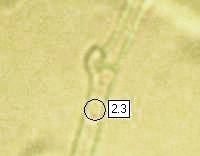 |
Hyphal structureWith clamp connections (pictured left). |
Odour/taste |
Not distinctive. |
Habitat & Ecological role |
Yellow Brain fungus grows on dead timber from all kinds of broad-leaf trees, but it is particularly common on fallen branches of birch and hazel. Very often (although easily overlooked) this colourful jelly fungus occurs also on decaying gorse wood. It is not the dead timber that Tremella mesenterica feeds upon but crust fungi that themselves have been feeding on the wood. Yellow Brain must therefore be - Classed as a parasitic rather than saprobic species. In Britain and Ireland (and probably elsewhere) it attacks corticioid (crust) fungi in the genus Peniophora. |
Season |
Yellow Brain fungus can be found in Britain and Ireland throughout the year, but it is most prevalent (and in particular most visible) in late autumn and early winter. |
Similar species |
Tremella aurantia is parasitic on Hairy Curtain Crust Stereum hirsutum, which occurs on dead hardwoods, particularly oaks and Beech. Its spores are subglobose (nearly spherical). Tremella foliacea is brown and has a lobed structure. |
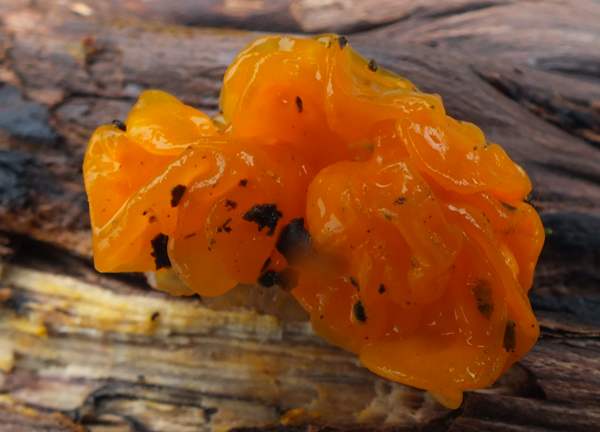
Culinary Notes
Most authorities say that this is an edible but very poor fungus while some field guides refer to it as inedible; however, because Tremella mesenterica is so insubstantial it probably has little or no culinary value.
Reference Sources
Fascinated by Fungi, 2nd Edition, Pat O'Reilly 2016, reprinted by Coch-y-bonddu Books in 2022.
Dictionary of the Fungi; Paul M. Kirk, Paul F. Cannon, David W. Minter and J. A. Stalpers; CABI, 2008
Taxonomic history and synonym information on these pages is drawn from many sources but in particular from the British Mycological Society's GB Checklist of Fungi.
Fascinated by Fungi. Back by popular demand, Pat O'Reilly's best-selling 450-page hardback book is available now. The latest second edition was republished with a sparkling new cover design in September 2022 by Coch-y-Bonddu Books. Full details and copies are available from the publisher's online bookshop...

